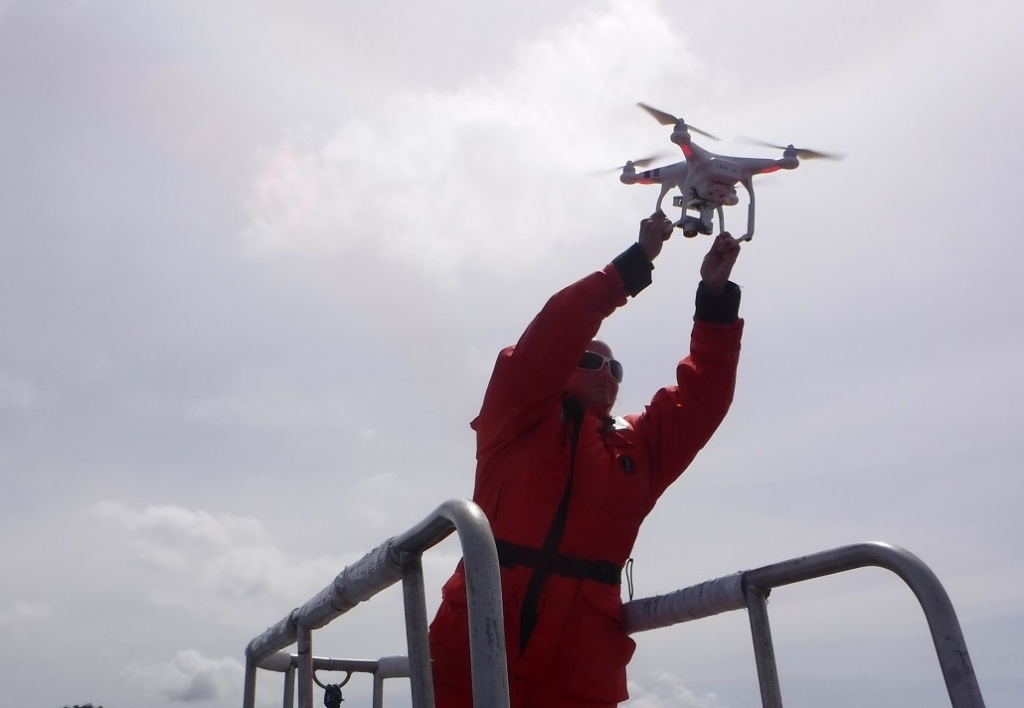Assistant Professor Leigh Torres leads the Geospatial Ecology of Marine Megafauna Lab of Oregon State University and is interested in how marine species use their environment and how that information can inform conservation management plans. Leigh studies multiple aspects of the gray whales of Oregon, including their foraging ecology, how they’re impacted by ocean noise, assessing their health using drones and hormone analysis, and working to reduce the risk of whale entanglement in fishing gear.

One of your projects is looking at how ambient ocean noise levels affect the reproductive and stress hormones and body condition of gray whales that forage along the Oregon coast between May and October each year. Have you noticed any trends in ocean noise levels and gray whale health since this study began in 2015? If so, have you detected any correlation between the two?
Yes, we have found some interesting trends. First ambient ocean noise is variable along the Oregon coast, and is significantly louder near ports. We have also detected a positive correlation between vessel traffic and noise levels. Our preliminary hormone analysis results show an increase in the stress hormones (cortisol) in gray whales with increased vessel traffic. We are currently digging into these patterns more to determine if whales are responding to the noise or the vessel traffic itself, or both. But so far the results are very interesting.

There are plenty of other potential sources of stress for the gray whales besides ocean noise, including changing oceanographic conditions (not only ‘the blob’, but also variable upwelling, the occurrence of El Niño, etc), the risk of entanglement in fishing gear, and disturbance from whale-watching vessels. Do you think there’s a single issue that most threatens the health of gray whales, or should we be most concerned about the cumulative impacts of these threats?
All of those disturbances are important to consider together when we try to assess impacts on a whale population, and thus manage that population to be sustainable. We are often forced to study different aspects in isolation due to logistics, funding and feasibility, but we have to remember that the whales don’t live like that – paying attention to just one impact at a time. They often deal with all these impacts and scenarios together. Our work on gray whales tries to account for many aspects of their lives at once (sex, age, ambient noise, behaviour, nutrition) but we can’t get it all. It’s a first step in that direction.

You are also working to identify areas of co-occurrence between whales and fishing activities in Oregon to reduce the risk of entanglement in fishing gear. The recent marine heatwave has been linked to the shoreward movement of foraging humpback whales in central California and an increase in humpback whale entanglements. Is entanglement a problem for gray whales in Oregon and are you aware of any recent changes in the rate of gray whale entanglements?
Gray whales do get entangled in fishing gear, but their rate of entanglement has not increased significantly over the last five or ten years. Last year we even saw two entangled gray whales in our study region. We have also had a rise in humpback whale abundance in Oregon waters recently that has led to an increased concern about entanglements here. Humpback and blue whales may be using Oregon waters more as oceans change and their prey moves northward. We are hoping that our whale distribution research will help protect the whales and support sustainable and profitable fisheries in Oregon.

